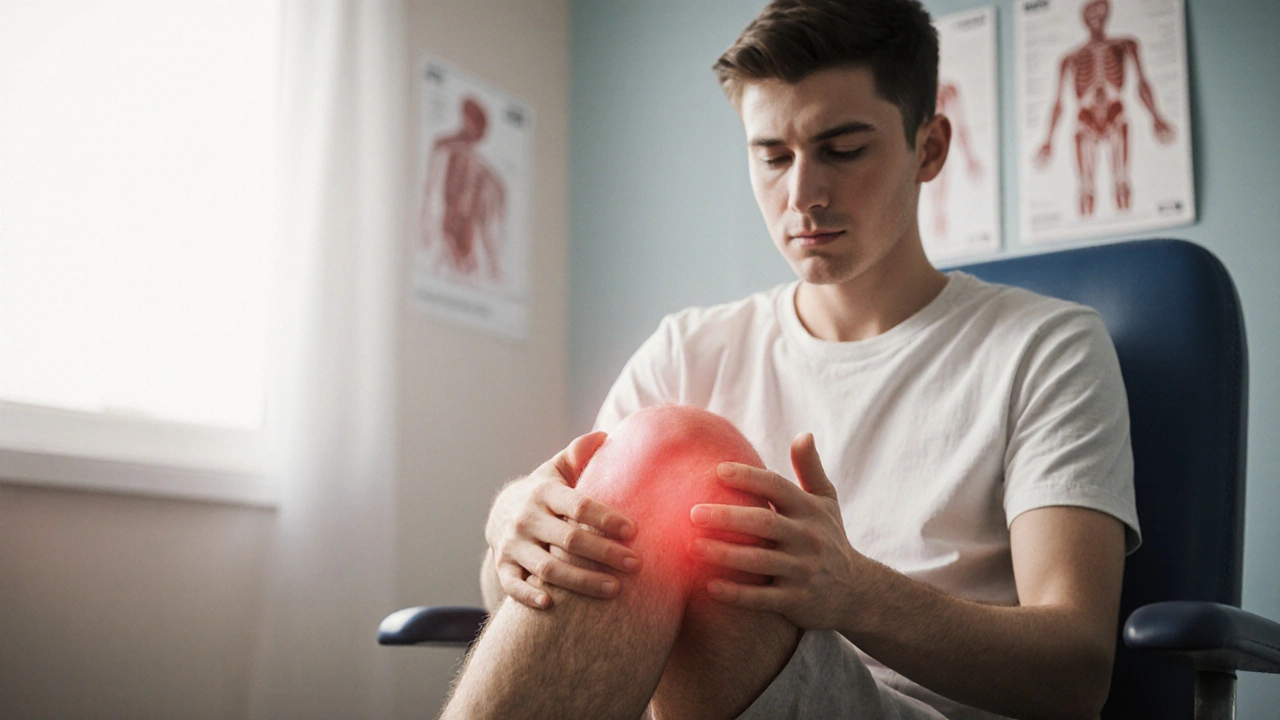Hemophilia Pain Management Calculator
Your Personalized Pain Management Recommendations
Living with hemophilia means your body can turn a simple bump into a painful bout of bleeding, especially in the joints. When those bleeds become frequent, chronic pain can shadow everyday life. Below you’ll find practical ways to keep that pain in check without compromising safety.
What is hemophilia and why does it cause pain?
Hemophilia is a genetic bleeding disorder characterized by a deficiency of clotting factors, most commonly Factor VIII (HemophiliaA) or Factor IX (HemophiliaB). Without enough of these proteins, blood can’t clot normally, leading to prolonged bleeding after injuries or even spontaneously. The most painful episodes are hemarthrosis-bleeding into joints-which triggers inflammation, swelling, and eventually joint damage. Over time, repetitive bleeds turn acute aches into chronic pain that limits mobility.
Core principle: treat the bleed, then treat the pain
Effective pain relief starts with stopping the bleeding. The cornerstone of hemophilia care is factor replacement therapy. By infusing the missing clotting factor, you give the body the tools to close the wound and prevent further joint irritation. Once the bleed is under control, you can safely address the lingering pain.
1. Factor replacement and prophylaxis
- On‑demand infusions - Use factor concentrate when a bleed is identified. Prompt treatment (within 2‑4hours) limits joint damage.
- Prophylactic schedules - Regular infusions (2-3 times per week for severe hemophilia) keep factor levels high enough to prevent bleeds altogether.
- Extended‑half‑life products - Newer recombinant factors stay active longer, reducing infusion frequency and thus lowering pain from needle sticks.
- Gene therapy - For select adults with hemophiliaA or B, a one‑time infusion can raise endogenous factor levels, dramatically cutting bleed frequency and pain episodes.
2. Managing “inhibitors” - antibodies that neutralize factor
Up to 30% of people with severe hemophilia develop inhibitors, making standard factor replacement ineffective. Strategies include:
- Bypassing agents such as activated prothrombin complex concentrates (aPCC) or recombinant activated factor VII.
- Immune tolerance induction (ITI) - frequent high‑dose factor infusions to retrain the immune system.
- During inhibitor episodes, pain management must rely more on non‑factor options and physical therapies.
3. Pain‑relieving medications - choose wisely
Because the bleeding risk is central, not all analgesics are safe. Below is a quick comparison of common options.
| Medication | Mechanism | Bleeding risk | Typical use |
|---|---|---|---|
| Acetaminophen (Paracetamol) | Central COX inhibition | None | First‑line for mild‑moderate pain |
| NSAIDs (Ibuprofen, Naproxen) | Peripheral COX inhibition | Increases bleed risk - generally avoided | Only under hematology supervision |
| Opioids (Tramadol, morphine) | µ‑opioid receptor agonist | No impact on clotting | Moderate‑severe pain; short‑term use |
Guideline tip: start with acetaminophen, reserve NSAIDs for special cases, and keep opioids as a backup for breakthrough pain. Always coordinate with your hemophilia treatment center before adding any new drug.
4. Desmopressin - a hormone boost for mild hemophiliaA
Desmopressin (DDAVP) stimulates the release of stored FactorVIII and von Willebrand factor, offering a needle‑free option for certain minor bleeds or surgical prophylaxis. It’s ineffective for hemophiliaB or severe cases, but when appropriate, it reduces both bleeding and the pain that follows.
5. Physical therapy and joint protection
After a bleed is cleared, get moving-carefully. A qualified physiotherapist can design a program that:
- Restores range of motion without overstressing the joint.
- Strengthens surrounding muscles to off‑load the joint.
- Teaches safe lifting and daily‑activity techniques.
Regular, low‑impact exercises (swimming, cycling, elliptical) keep joints supple and lower the frequency of painful bleeds.
6. Compression therapy and orthoses
Wearing compression sleeves or custom braces after a joint bleed can:
- Control swelling.
- Improve proprioception, reducing re‑bleed risk.
- Provide mild analgesia through gentle pressure.
Choose a size that’s snug but not restrictive. Replace orthoses every 1-2years as muscles and joints change.

7. Lifestyle tweaks that cut pain
- Weight management - Extra pounds add stress to weight‑bearing joints, amplifying bleed‑related pain.
- Warm‑up routines - A five‑minute gentle warm‑up before activity prepares the joints and may prevent micro‑trauma.
- Hydration and nutrition - Adequate protein and vitaminD support tissue repair.
- Stress reduction - Chronic stress can heighten pain perception; mindfulness or yoga can help.
Quick checklist for daily pain control
- Check factor levels before any activity; use prophylaxis if needed.
- Carry a rescue dose of factor or bypassing agent on hand.
- Start with acetaminophen for new aches; only add NSAIDs after consulting your hematologist.
- Apply a compression sleeve within 24hours of a joint bleed to limit swelling.
- Schedule a physiotherapy session within 48hours after bleed resolution.
- Log pain scores, bleed events, and medication use in a journal - it guides treatment adjustments.
When to seek professional help
If you notice any of these signs, contact your hemophilia center immediately:
- Sudden, severe joint pain that doesn’t improve after a factor infusion.
- Swelling that spreads beyond the joint or is accompanied by warmth and fever.
- Persistent pain lasting more than a week, indicating possible chronic joint disease.
- New or worsening nerve‑related symptoms (tingling, weakness) in the affected limb.
Frequently Asked Questions
Can I use ibuprofen for hemophilia‑related pain?
Ibuprofen and most NSAIDs can impair platelet function and increase bleeding risk, so they are generally avoided in hemophilia unless a hematologist specifically approves a short course.
Is long‑term opioid use safe for chronic hemophilia pain?
Opioids do not affect clotting, but they carry risks of tolerance, dependence, and side‑effects. They should be limited to short‑term flare‑ups, with a clear weaning plan and regular review by both pain and hematology specialists.
How often should I do factor prophylaxis?
For severe hemophilia, most centers recommend 2-3 infusions per week to keep trough factor levels above 1%-3%. The exact schedule is individualized based on bleed history, activity level, and factor product used.
What role does gene therapy play in pain reduction?
By raising endogenous factor levels to near‑normal, gene therapy can cut spontaneous bleeds by up to 90%, which directly translates to fewer painful joint episodes and improved quality of life.
Are there any safe home remedies for minor joint aches?
Gentle elevation, cool packs (if swelling is present), and acetaminophen are safe. Avoid heat or vigorous massage on a fresh bleed, as these can re‑initiate bleeding.


Rohinii Pradhan
October 8, 2025 AT 22:02When confronting the multifaceted challenge of hemophilia‑related pain, it is essential to adopt a holistic framework that transcends mere symptom suppression. First and foremost, timely factor replacement remains the linchpin of any therapeutic algorithm, for an untreated bleed inexorably precipitates synovial inflammation and irreversible arthropathy. Equally indispensable is the judicious employment of analgesics that honor the delicate hemostatic balance; acetaminophen, with its negligible impact on platelet function, should constitute the cornerstone of pharmacologic relief. NSAIDs, by virtue of their antiplatelet activity, warrant strict reservation and only under the vigilant supervision of a hematologist. Should the pain intensity surpass the modest thresholds amenable to acetaminophen, short‑term opioid therapy may be invoked, yet always with a clear weaning strategy to forestall dependence. Physical rehabilitation, instituted promptly after bleed resolution, restores range of motion, fortifies peri‑articular musculature, and mitigates the risk of recurrent hemorrhage. Compression garments, when properly fitted, dampen edema, furnish proprioceptive feedback, and deliver a modest analgesic effect. Lifestyle modifications-maintaining optimal body mass, engaging in low‑impact aerobic exercise, and adhering to a nutritionally balanced diet rich in vitamin D and protein-further buttress joint resilience. In patients harboring inhibitors, bypassing agents and immune tolerance induction become pivotal, and analgesic choices must be calibrated accordingly. Emerging extended‑half‑life factor products and gene‑editing therapies promise to diminish infusion frequency, thereby alleviating procedural discomfort and enhancing adherence. Ultimately, a patient‑centric plan, synergistically integrating hemostatic control, pain pharmacology, physiotherapy, and psychosocial support, yields the most favorable outcomes in preserving both function and quality of life.
Anna-Lisa Hagley
October 9, 2025 AT 00:46The relentless march of chronic hemophilic pain mirrors a Kafkaesque labyrinth where every analgesic choice feels like a sacrificial pact. One must navigate these murky waters with a skeptical eye.
A Walton Smith
October 9, 2025 AT 03:33Acetaminophen is fine.
Theunis Oliphant
October 9, 2025 AT 07:43It is a grave misstep to glorify any medication that threatens the fragile clotting cascade. A moral compass must steer us toward the safest analgesic. Remember, simplicity can be a virtue. The humble acetaminophen exemplifies this principle.
Josh SEBRING
October 9, 2025 AT 09:06While the moral tenor is admirable, the reality of breakthrough pain often forces a pragmatic compromise. Even a brief opioid course can be justified when bleeding is staunched.
Lily Tung
October 9, 2025 AT 13:16From a practical standpoint, the cascade of therapies presented offers a comprehensive scaffolding for patients navigating hemophilia‑related discomfort; each component, from prophylactic infusions to targeted physiotherapy, interlocks with the others to forge a resilient defense against both acute bleeds and chronic arthropathy. Moreover, the emphasis on lifestyle interventions-weight management, low‑impact aerobic activity, and nutritional adequacy-serves not merely as an adjunct but as a foundational pillar that can dramatically attenuate the frequency of hemorrhagic episodes. The nuanced discussion of inhibitor management, including bypassing agents and immune tolerance induction, underscores the necessity of individualized care plans that can adapt to the evolving immunologic landscape of each patient. Finally, the forward‑looking glimpse into gene therapy and extended‑half‑life factors hints at a future wherein the burden of frequent infusions, and the attendant procedural pain, may become a relic of the past.
Ujjwal prakash
October 9, 2025 AT 14:40Exactly! The integration of compression sleeves-especially within the first 24 hours-can dramatically reduce edema; likewise, gentle elevation and cool packs are indispensable tools. It’s crucial to avoid heat on a fresh bleed-heat can provoke re‑bleeding! And let’s not forget that logging pain scores daily empowers both patient and clinician to fine‑tune therapy.
Diane Helene Lalande
October 9, 2025 AT 18:50It's encouraging to see such a thorough overview of pain mitigation strategies. Remember to keep a personal pain diary; it helps your care team tailor interventions. Consistency in physiotherapy sessions also makes a big difference.
Edwin Levita
October 9, 2025 AT 20:13Indeed, the drama of chronic joint pain can be softened by disciplined rehabilitation. Yet, without proper clotting support, even the best exercises fall short.
Xander Laframboise
October 10, 2025 AT 00:23A balanced approach to hemophilia pain hinges on timing; prophylactic factor infusions should precede any strenuous activity to forestall bleeding. Subsequently, acetaminophen can address residual aches without compromising hemostasis. For breakthrough pain, short‑term opioids are a viable bridge, provided they are tapered promptly. Finally, the role of patient education cannot be overstated-knowledge empowers better self‑management.
Jason Petersen
October 10, 2025 AT 01:46Timely prophylaxis is the linchpin; any lapse invites unnecessary pain.
Melissa Gerard
October 10, 2025 AT 05:56Honestly, all this talk about “multimodal therapy” feels like over‑engineering 🙄.
Cindy Knox
October 10, 2025 AT 07:20While the skepticism is noted, the lived reality of hemophilic pain often demands the very “multimodal” approach described. A compassionate tone can go a long way.
beverly judge
October 10, 2025 AT 11:30For anyone refining their regimen, consider a weekly check‑in with your hemophilia team to discuss factor levels and pain scores. Sharing your journal can reveal subtle patterns that merit adjustment. Collaborative care remains the gold standard.
Capt Jack Sparrow
October 10, 2025 AT 12:53Exactly, and don’t underestimate the value of a simple reminder app to track doses. It keeps you on schedule without fuss.
Manju priya
October 10, 2025 AT 17:03Stay motivated, stay proactive! Your commitment to regular physiotherapy and proper factor administration paves the road to fewer painful episodes. Keep logging those scores 😊.
Jesse Groenendaal
October 10, 2025 AT 18:26Let us not forget that neglecting prophylaxis is a moral failing when effective options exist. Adherence is a responsibility we all share.